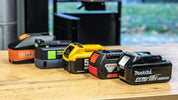
Cordless Tools: Charging Times, Tips and Technology
, by Lucas Meyer, 4 min reading time

, by Lucas Meyer, 4 min reading time

In the past, many tools relied on power supply via cable or petrol. But nowadays, more and more devices, from lawnmowers to cordless screwdrivers, rely on the practical solution with batteries. Battery-powered tools are very popular, especially among DIY enthusiasts and professionals, as they offer significantly more mobility due to their flexibility and independence from power outlets.
Before we deal with the charging times of batteries, here are a few tips on how to get the most out of your batteries:
The charging time of batteries depends on various factors, such as the capacity of the battery and the charger used. You can calculate the charging time yourself using the following formula:
Charging time = (Battery capacity in mAh) / (Charging current in mA) * 1,3
You can usually find the battery capacity on the battery itself and the charging current on the back of the charger.
Note: This formula gives you a rough estimate of the charging time. In practice, chargers can use different charging methods, such as fast charging, which can shorten the charging time. In addition, the temperature and condition of the battery can influence the actual charging time.
The following charging times apply to the chargers DC18RC and DC18RD:
In the world of batteries, there is a variety of technologies. Some older battery types have now been replaced by more powerful models that both reduce charging time and increase endurance.
Currently, Lithium-ion batteries are the most common and powerful batteries on the market. They offer high energy density and are more efficient than their predecessors. The Lithium-ion battery was introduced to the market in 1991, although basic research on these batteries was already conducted in the 1970s.
Batteries should be stored in a cool, dry place, ideally at temperatures between 15 and 25°C. Avoid direct sunlight or storage in very hot or cold environments, as extreme temperatures can shorten the battery's lifespan. It is also advisable to charge the battery to about 40-60% of its full capacity before storing it – this prevents deep discharge or overcharging, which could damage the battery. Make sure to check the battery regularly if you are not using it for a long time and recharge it if necessary.
In the media, one repeatedly hears reports of exploding batteries in devices like smartphones or headphones that were damaged by overheating. However, such incidents are rare and usually happen with cheaper devices that do not have the necessary safety technology.
With high-quality batteries, such as those from established manufacturers, the risk of spontaneous self-ignition is very low when used and stored correctly. The most important thing is to always observe the manufacturer's recommendations when charging and storing your batteries.
Battery-powered tools offer enormous flexibility and efficiency, especially for DIY projects or on the construction site. However, to benefit from the advantages of this technology, it is important to understand the charging times, proper battery care, and the latest battery technologies. With the tips mentioned above, you are well-equipped to use your batteries efficiently and enjoy your tools for a long time.

Hey Bro, bist du auf der Suche nach dem Toolbrothers RELAX Raumduft Gewinnspiel? Dann bist Du hier genau richtig! Passend zu den Herbst-Vibes starten wir direkt...

Hey Bro, bist du auf der Suche nach dem neuesten Toolbrothers Gewinnspiel?Dann bist du hier genau richtig! Bis Dienstag, den 14.10.2025 haben 5 TB-Follower die...

Hey Bro, bist du auf der Suche nach dem neueste Toolbrothers Gewinnspiel? Du willst das Stepbrother Schuh-Deo testen? Dann bist Du hier genau richtig! Bis Montag, den...

Hey Bro, bist du auf der Suche nach dem MAKITA DHP 492 Gewinnspiel? Dann bist Du hier genau richtig! Passend zu den neuesten MAKITA BROdeals starten wir...